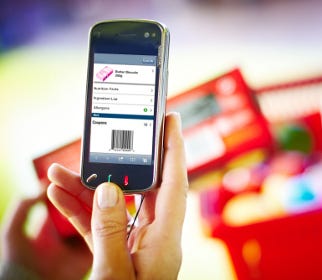Consumers often let down when scanning bar codes in stores
January 30, 2014

Consumers often let down when scanning bar codes in stores
A new report co-authored by GS1 and Capgemini cautions companies selling consumer products that much of the digital product information accessible via smartphones and the Internet is incomplete or wrong.
The report, titled "Beyond the Label: Providing Digital Information Consumers Can Trust," addresses a "perfect storm" of three converging forces: consumer demand for more information; increased smartphone usage; and a widening variety of data sources, leading to an explosion of data.
Consumers' interest in researching products is illustrated by the finding that more than two-thirds of consumers want nutrition and ingredient information, while more than 30 percent of smartphone users have downloaded a bar code scanning application, with usage of these apps jumping 1,600 percent in 2010.
But the results these consumers get frequently let them down, depending on where their searches take them and the incorrect product information often received.
The report cites recent research by GS1 UK and the Cranfield School of Management in which 91 percent of mobile bar code scans returned incorrect product descriptions and 75 percent returned no data. The report also cites New York-based Scanbuy's finding that 40 percent of requests processed through its ScanLife application cannot be authoritatively connected to a product.
Available free for download, the report was written by Capgemini, a leading provider of consulting, technology and outsourcing services, and several country-based member organizations of not-for-profit standards group GS1, including GS1 US and GS1 UK.
"Brand owners—both retailers and manufacturers—and application providers need to understand the severity of this problem," says Bob Carpenter, president/CEO of GS1 US. "We found that 38 percent of consumers will not purchase a product if they don't trust the information they get on a smartphone, and 35 percent may stop using an app if they get the wrong information."
The growth of the Internet and smartphone scanning have spurred sharp growth in new business-to-consumer (B2C) data sources, including third-party or "crowd-sourced" sites, where brand owners have little or no control over the information about their products.
The report explains the scope of the challenge; provides guidance to industry; and issues a call to action for brand owners to participate in several cross-industry initiatives to develop best practices that protect their brands and meet consumers' needs.
The authors advise brand owners to begin rigorous data-integrity programs and collaborate with other companies to improve the consumer experience in researching products.
"Improving digital product information for consumers requires that all relevant players understand their responsibility to work together collaboratively and in a consistent manner," says Bob Fassett, vp, North America Consumer Goods, Retail and Distribution Leader, Capgemini.
"The right solution can help the industry realize the digital data vision: Brand owners can share relevant product information easily, thus building trust with consumers; application providers can ensure they are delivering authentic data; and consumers can feel confident that the digital product information they access is accurate, no matter how or where they shop," he says.
The report is free and can be downloaded at www.gs1us.org/library?EntryId=3651&Command=Core_Download, or www.capgemini.com/insights-and-resources/by-publication/beyond-the-label/.
Source: GS1 US
.
About the Author(s)
You May Also Like


